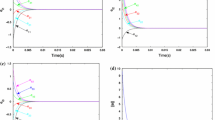Abstract
This paper is concerned with the quantized synchronization control problem of coupled dynamic networks (CDNs) with communication constraints. The networked-induced delay, data packet dropouts, and signal quantization effects are simultaneously considered in the synchronization controller design. A new closed-loop coupled dynamic system is constructed, where both the interval time-varying delays and quantized parameters are taken into account. By using Kronecker product technique and the Lyapunov–Krasovskii functional approach, a stability criterion is obtained for the closed-loop CDNs, which also guarantees that the CDNs are synchronized. Then, both the networked controller and the quantized parameters can be designed. Finally, a simulation example is given to illustrate the effectiveness of the proposed method.


Similar content being viewed by others
References
Grassi M, Morbidoni C, Nucci M. A collaborative video annotation system based on semantic web technologies. Cogn Comput. (2012); 4:497–514.
Pal A, Tiwari R, Shukla A. Multi-robot exploration in wireless environments. Cogn Comput. (2012); 4:526–42.
Zhong L, Zhu GX, Kong ZM, Liu J. Distributed interference alignment algorithm for multiple-input multiple-output netwroks with uncoordinated interference. Cogn Comput. (2012) (in press).
Kozma R, Puljic M. Learning effects in couled arrays of cellular neural oscollators. Cogn Comput. (2012) (in press).
Puljic M, Kozma R. Broad-band oscillations by probabilistic cellular automata. J Cell Autom. (2010); 5:491–507.
Samar R, Kamal WA. Optimal path computation for autonomous aerial vehicles. Cogn Comput. (2012); 4:515–25.
Yan XD. Dissociated emergent response system and fine-processing system in human neural network and a heuristic neural architecture for autonomous humanoid robots. Cogn Comput. (2011); 3(2):367–73.
Liang JL, Wang ZD, Liu YR, Liu XH. Robust synchronization of an array of coupled stochastic disscrete-time delayed neural networks. IEEE Transactions on Neural Netw. (2008); 19:1910–21.
Ukhtonsky AA. Collected works (in Russian), Leningrad Russia: Nauka, pp.107–237; (1978).
Zhang HG, Wang G. New criteria of global exponential stability for a class of generalized neural networks with time-varying delays. Neurocomputing (2007); 70:2486–94.
Zheng CD, Zhang HG, Wang ZS. Delay-dependent globally exponential stability criteria for static neural networks: an LMI approach. IEEE Transactions on Circuits and Systems II: Express Briefs. (2009); 56:605–9.
Zhang HG, Liu Z, Huang G, Wang ZS. Novel weighting-delay-based stability criteria for recurrent neural networks with time-varying delay. IEEE Trans Neural Netw. (2010); 21:91–106.
Gong DW, Zhang HG, Wang ZS, Huang BN. Novel synchronization analysis for complex networks with hybrid coupling by handling multitude Kronecker product terms. Neurocomputing (2012); 82:14–20.
Tang HW, Chen L, Lu JA, Tse Chi K. Adaptive synchronization between two complex networks with nonidentical topological structures. Physica A. (2008); 30:387–95.
Wang XF, Chen G. Synchronization in scale-free dynamical networks: robustness and fragility. IEEE Trans Citcuits Syst I. (2002); 49:54–62.
Liu WL, Chen TP. Synchronization of coupled connected neural networks with delays. IEEE Trans Citcuits Syst I. (2004); 51:2491–2503.
He G, Yang J. Adaptive synchronization in nonlinearly coupled dynamical networks. Chaos Solitons Fract. (2008); 41:12–9.
Zheng S, Wang SG, Dong CG, Bi QS. Adaptive synchronization of two nonlinearly coupled complex dynamical networks with delayed coupling. Commun Nonlinear Sci Numer Simulat. (2012); 17:284–91.
Li Z. Global exponential synchronization criterion for switched linear coupled dynamic networks. Chaos Solitons Fract. (2012); 45:496–502.
Cao JD, Chen GR, Li P. Global synchronization in an array of delayed neural networks with bybrid coupling. IEEE Trans Syst Man Cybern B. (2008); 38:488–98.
Li H, Yue D. Synchronization of Markovian jumping stochastic complex networks with distributed time delays and probabilistic interval discrete time-varying delays. Phys A Math Theor. (2010); 43(10):105101-1–105101-26.
Shen B, Wang ZD, Liu XH. Bounded \(H_{\infty}\) synchronization and state estimation for discrete time-varying stochastic complex networks over a finite horizon. IEEE Trans Neural Netw. (2011); 22:145–57.
Wang YC, Zhang HG, Xu XY, Yang DS. Networked synchronization control of coupld dynamic networks with time-varying delay. IEEE Trans Syst Man Cybern B. (2010)l; 40:488–98.
Hui GT, Liu YS, Wang YC. Design for networked control systems with compound markovian transition probabilities, modeling, identification and control (ICMIC). In: Proceedings of 2011 international conference on, pp.572–577 (2011).
Zhao YB, Liu GP. Stochastic stabilization of packet-based networked control systems. Int J Innov Comput Inf Control. (2011); 7:2441–55.
Mao ZH, Jiang B, Shi P. Fault-tolerant control for a class of nonlinear sampled-data systems via a Euler approximate observer. Automatica. (2010); 46:1852–9.
Zhang HG, Quan YB. Modeling, identification, and control of a class of nonlinear systems. IEEE Trans Fuzzy Syst. (2001); 9:49–354.
Zhang H, Yan HC, Yang FW, Chen QJ. Quantized control design for impulsive fuzzy networked systems. IEEE Trans Fuzzy Syst. (2011); 19:1153–62.
Fagnani F, Zampieri S. Quantized stabilization of linear systems: complexity versus performance. IEEE Trans Autom Control (2004); 49(9):1534–48.
Sqartini S, Schuller B, Hussain A. Cognitive and emotional infromation processing for human-machine interaction. Cogn Comput (2012); 4:383–5.
Kim JB, Park JS, Oh YH. Speaker-characterized emotion recognition using online and iterative speaker adaptation. Cogn Comput. (2012); 4:398–408.
Perlovsky LI, Levine DS. The drive for creativity and escape from creativity: neurocognitive mechanisms. Cogn Comput. (2012); 4:292–305.
Wang J, Wang YC, Hui GT. The research of power battery with ultra-capacitor for hybrid vehicle. In: 8th international symposium on neural networks, ISNN 2011, Guilin, China; 2011. p. 274–9.
Acknowledgments
This work was supported by the National Natural Science Foundation of China (60904017, 61034005), Program for New Century Excellent Talents in University of China (NCET-10-0306), and the Fundamental Research Funds for the Central Universities (N100404024, N100104102).
Author information
Authors and Affiliations
Corresponding author
Rights and permissions
About this article
Cite this article
Hui, G., Huang, B., Wang, Y. et al. Quantized Control Design for Coupled Dynamic Networks with Communication Constraints. Cogn Comput 5, 200–206 (2013). https://doi.org/10.1007/s12559-013-9203-6
Received:
Accepted:
Published:
Issue Date:
DOI: https://doi.org/10.1007/s12559-013-9203-6




